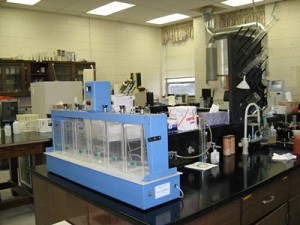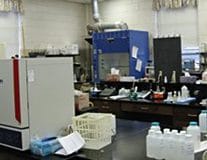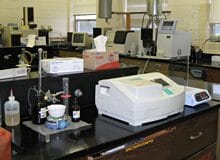The Laboratory
The Labo
Federal and State regulations guide the activities of the Laboratory and the reporting of analytical results in compliance with the U.S. Environmental Protection Agency’s Safe Drinking Water Act, the Virginia Department of Health Operating Permit, as well as the Department of Environmental Quality’s VPDES permit which regulates our discharges back to the reservoir or the Appomattox River.


The Brasfield Dam
The Brasfield Dam impounds a portion of the Appomattox River, forming Lake Chesdin. The Lake Chesdin Reservoir water storage volume estimates since 1968 are:
· 1968 As-built estimate = 12 billion gallons of water
· 2001 Recalculated 1968 as-built estimate based on 2001 Source Water Study by Gannett Fleming. This was determined from digitizing original contour maps = 10.5 billion gallons of water
· 2000 Bathymetric Survey = 9.6 billion gallons of water
· 2011 Bathymetric Survey = 9.3 billion gallons of water
Raw lake water passes through a bar screen in the dam that prevents large debris from entering the pump well of the dam. Water can be taken from one of four depths of the lake: four feet, 14 feet, 24 feet, or 33 feet. Water passes through a traveling screen that removes debris down to approximately 1/2″ in size.
The water then enters a pump suction well of the dam. One or more of five pumps (2 at 8 million gallons per day (pump 1 and pump 2) and three at 16 million gallons per day (pumps 3, 4 and five)) sends the water to the treatment plant by a 54-inch water line. At the end of the dam on the 54-inch water line, potassium permanganate can be added.
Rapid Mix Building
Water enters the chemical building and it is metered with a 54 inch meter. Lime (pH adjustment and alkalinity addition) and alum (coagulant) and chlorine or chlorine dioxide (oxidant and pre-disinfection) are added. A static mixer stirs the chemicals that were added.
Flocculators
Raw water with chemicals added is sent to one of ten floc basins which use horizontal paddles and over/under baffles. The slow stirring and baffling is to enable floc to begin to form. Stirring is done with progressively slower speeds, called “step flocculation”, as the mixture proceeds through the basins. Polymer is normally added to the water to aid in coagulation in these basins from pumps in the chemical building.
floc noun: a small, loosely aggregated mass of flocculent material, suspended in or precipitated from a liquid.
flocculent adjective: having a fluffy character or appearance.
1 : resembling wool, especially in loose, fluffy organization.
2 : containing, consisting of, or occurring in the form of loosely aggregated particles or soft flakes; a flocculent precipitate.
Coagulation or Settling Basins
Water is distributed from the floc basins into one of 12 settling basins. Three basins are on the old side of the plant and three are on the newer side of the plant. The majority of the floc created by chemical addition drops to the bottom of these basins, because of the density and weight of the floc. Sludge is removed by manually washing out the old basins every three months or by vacuum from the newer basins daily. The cleanest water is taken off the top at the ends of the basins.
Filter Building
Water is distributed from the settling basins into the filters located inside the main or Filter Building. There are 32 filters that work in pairs, eight old filters capable of 2.75 million gallons per day each and 24 newer filters capable of 3 million gallons per day each. The filter rate is 4 gallons per square foot of filter area per minute. Normally filters are used to less than the maximum rate of flow.
Filters are comprised of 24 inches of granular activated carbon, 12 inches of sand and 12 inches of gravel. The bottoms of the old filters are Wheeler “ball” bottoms and the newer filters are Leopold tile drains. Filters are backwashed when the first of the following conditions occurs:
- 100 hours of operation since backwashing,
- Six feet of head loss has occurred, or
- Turbidity greater than 0.10 NTU.
Pipe Gallery and Post-Chemical Area
Water from filters in operation is collected by a header pipe system in the pipe gallery and finally into a 54 inch pipe, where lime (pH adjustment to greater than seven), chlorine (for disinfection), phosphate (for pipe corrosion protection), and fluoride (for tooth decay protection) is added.
Post Chemical Addition
Water leaves the chemical area and goes to a mixer located next to clearwell number 2 where the post-chemicals are well mixed. SCADA (which is Supervisory Control And Data Acquisition) control then allows a sample of water to be taken, and the proper adjustment to caustic soda, fluoride and chlorine to be made. Water goes into the clearwell number 3 (5.5 million gallons of storage at 14 feet) where the required contact time with chlorine is obtained (CT equals concentration of chlorine multiplied by the time of contact).
After leaving clearwell number 3, the water is sampled, additional chlorine is added, ammonia is added, and caustic soda may be added. The chlorine and ammonia mix is called chloramines, a weaker but longer-lasting disinfectant than chlorine. SCADA can make these additions automatically, or the operator can make them.
Water is then metered to help with the automatic chemical adjustment, and then water goes into clearwell 1 and 2, which is 1 million gallons of storage at 14 feet.
Finished Water Pumping Station
Pump station number 1 is located partially on top of clearwell number 1, and pump station number 2 is on top of clearwell number 2. Water can be sent out by gravity (up to approximately 24 million gallons per day) or by pumping from the clearwell. There are two 8 million gallon per day pumps and three 16 million gallon per day pumps to pump to the localities. Additionally the surface wash, backwash, and two domestic water pumps are located in this area.
